- Home
- slideshows
- miscellaneous
- I ate at Benihana for the first time, and my disappointing experience made it clear how far Asian-American cuisine has come
I ate at Benihana for the first time, and my disappointing experience made it clear how far Asian-American cuisine has come
I went to the Benihana on West 56th Street, which is the original restaurant that Aoki opened in 1964.

It looked as Japanese on the inside as it did on the outside — which is to say, not very. I was led upstairs where diners were seated around teppanyaki grills. I noticed that I was the only person of East Asian descent in the restaurant.
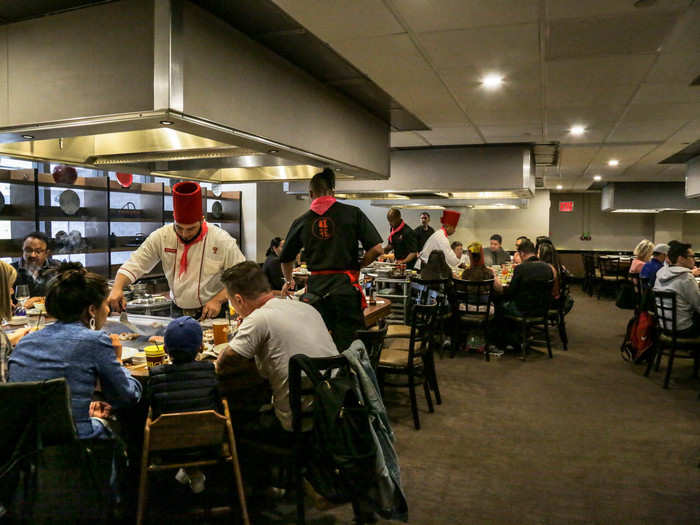
I was seated at a grill with a Texan family and a pair of Californian cousins who were studying in New York. The communal dining set-up encouraged us to converse, and I learned that both parties were regular Benihana fans. When our server arrived, he asked us if it was anyone's birthday. It wasn't.
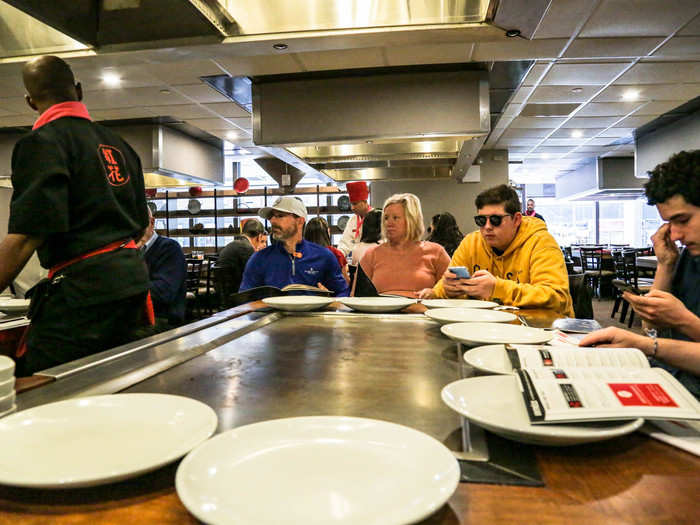
I ordered Benihana Punch in a collectible "Hotei" mug. These mugs have been a staple of the restaurant's decor since its inception. They used to come with cocktail umbrellas. Without one, mine looked painfully monochromatic.
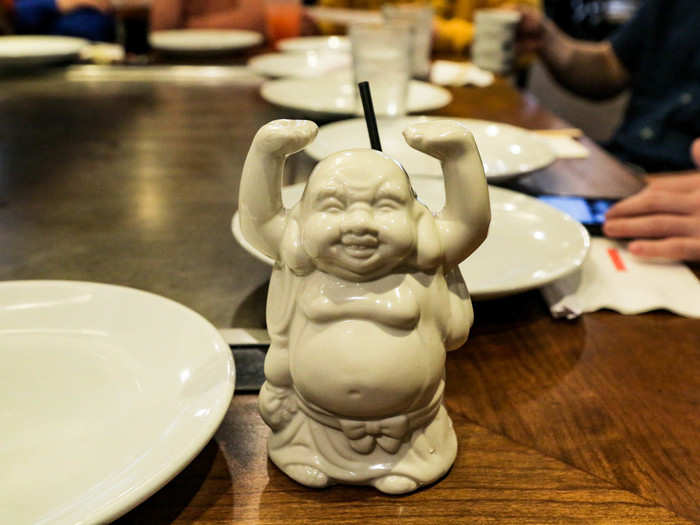
Turning it around, I realized that it looked like an evil cultist in the middle of a demonic ritual. But the drink inside was much less interesting. It was watery and tasted like punch made from a mix. I couldn't tell if there was even alcohol in it.
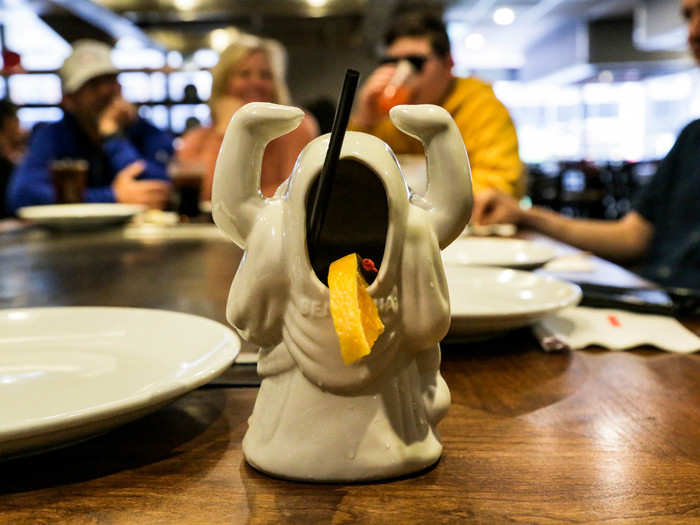
For my meal, I ordered Rocky's Choice, which includes soup, salad, hibachi shrimp, steak, chicken, ice cream, and green tea. I added on a side of chicken fried rice and a sashimi sampler appetizer. Our server brought over Benihana salad and onion soup to start.
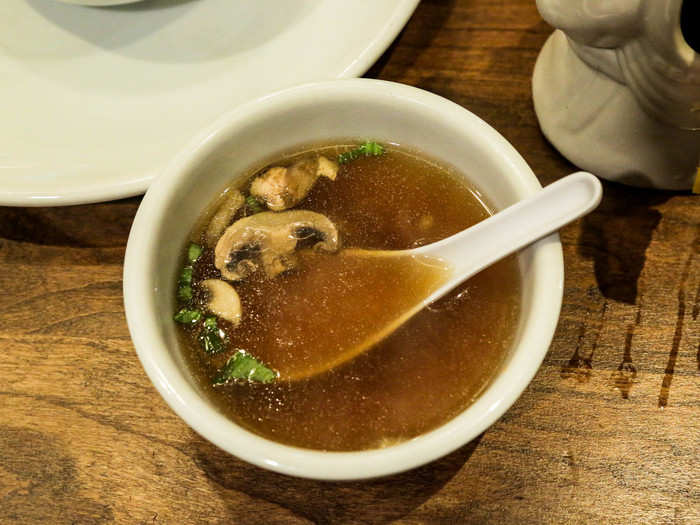
It was mild, mushroomy water — a broth at best, and not a particularly exciting one at that.
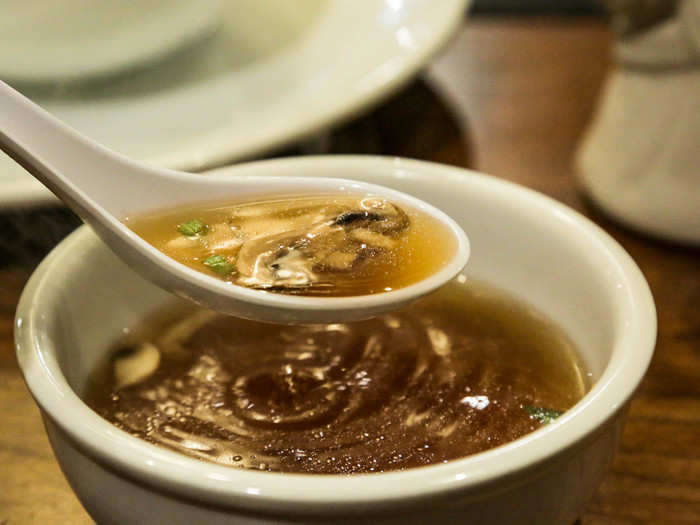
The Benihana Salad looked like any old salad you'd get from your neighborhood sushi or teriyaki joint. Its ingredients were neither the freshest nor the highest quality.
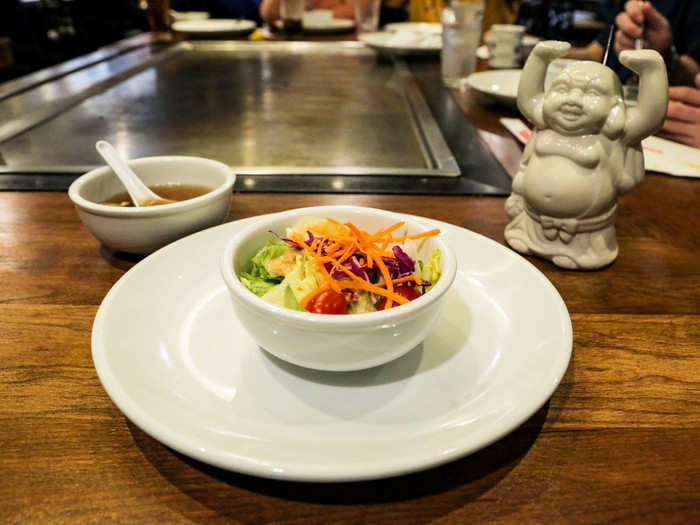
The ginger dressing was more oniony than the soup was.
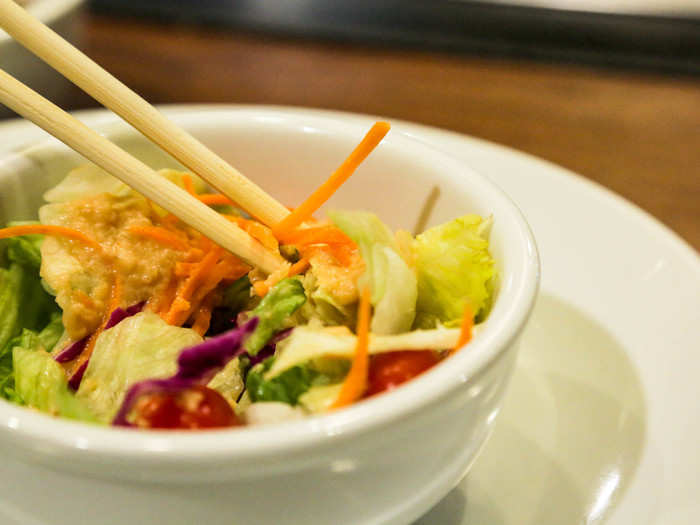
Haque, our chef, arrived with his cart and greeted us with a bow and an attempt at "Irasshaimase" — the Japanese phrase used to welcome guests to a store or restaurant. He immediately began flipping spatulas.
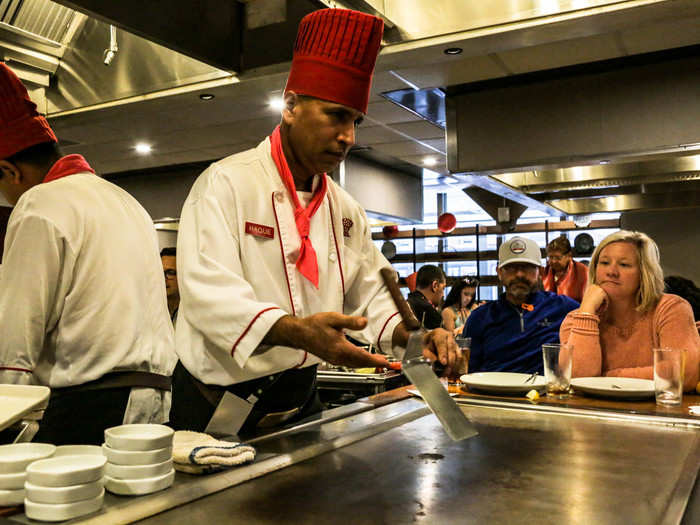
On the cooking cart, there were Japanese cooking staples like soy sauce and sunflower oil. However, the large tub of garlic butter stood out to me as a distinctly American condiment.
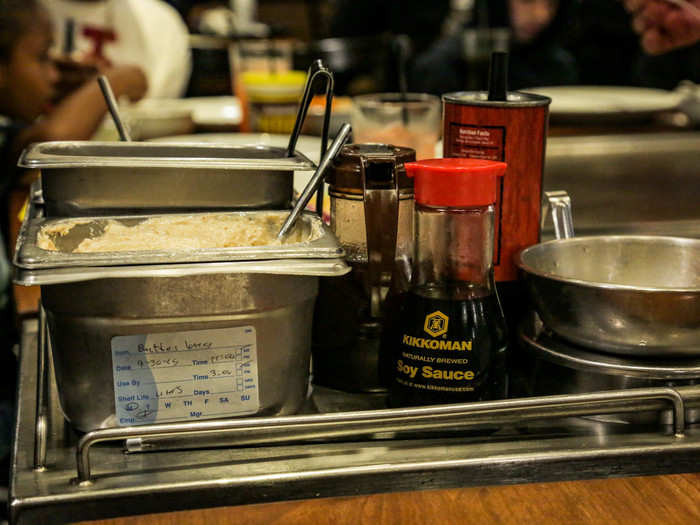
My sashimi sampler arrived with the chef. On the plate were snapper, tuna, and salmon sashimi.
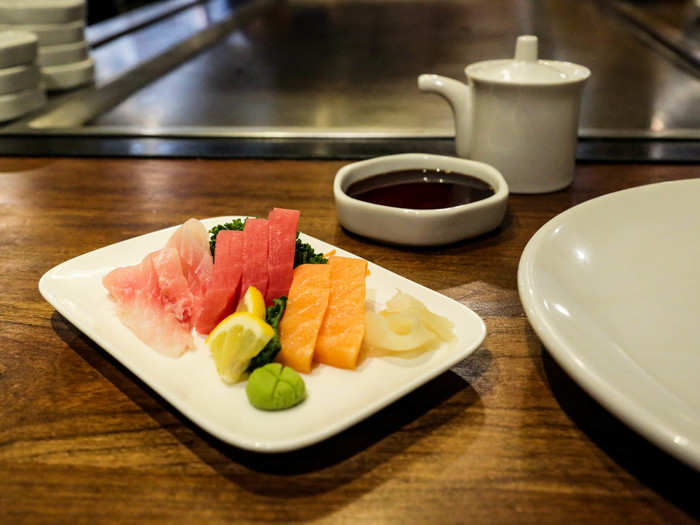
The sashimi looked clean and uniformly cut, although it lacked the fatty sheen I look for in raw fish.
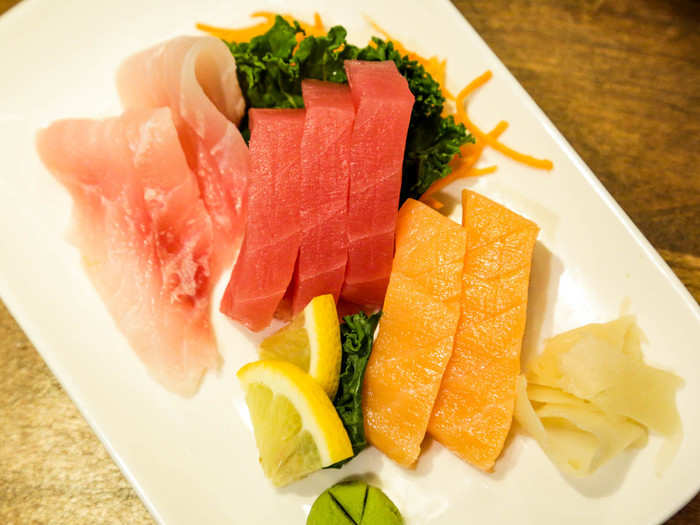
It tasted very fishy and was neither fresh nor fatty. I turned my attention to the food cooking on the grill top.
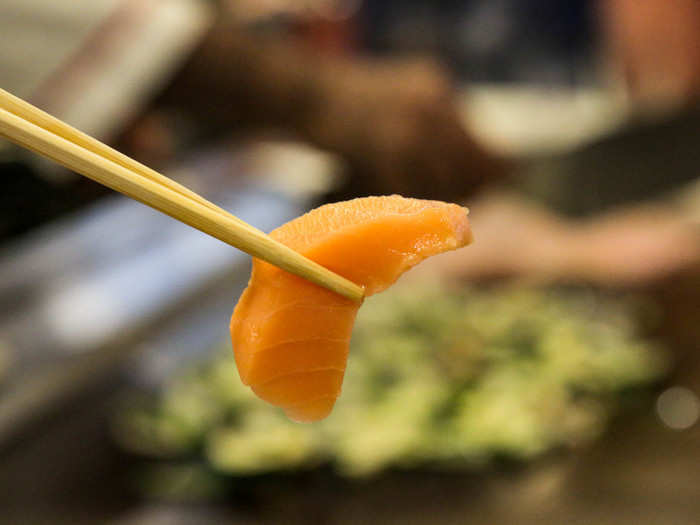
Chef Haque swept veggies, chicken, and mushrooms onto the hot metal.
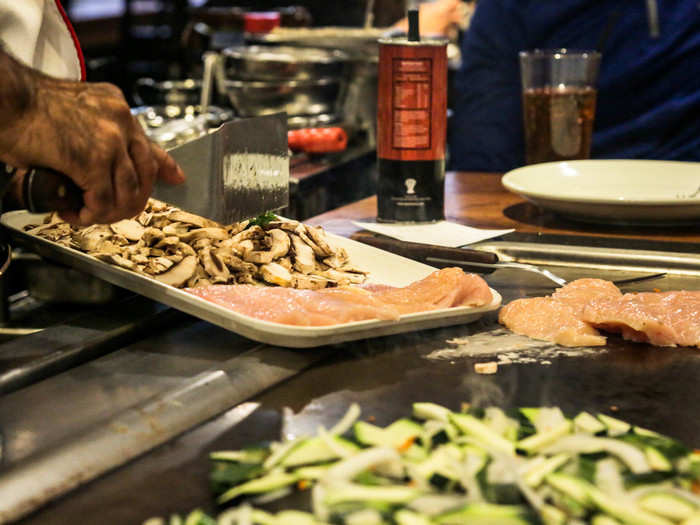
He parsed an onion into thirds and stacked it into a cone. Then, he dimmed the lights and doused the onion with two kinds of oil. It was time for the onion volcano.
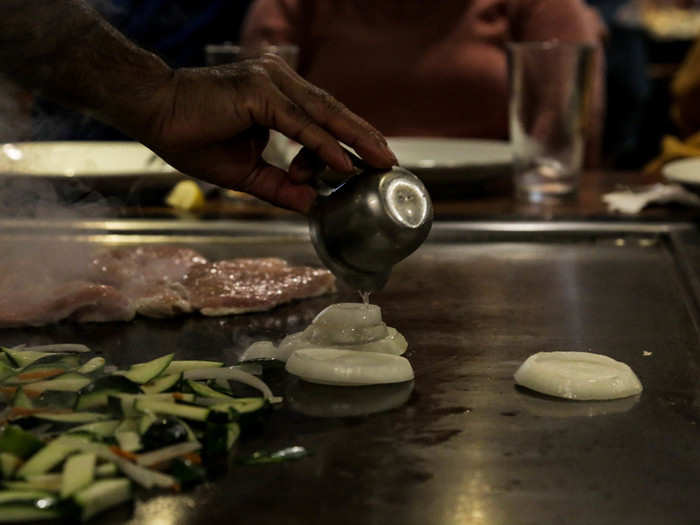
Chef Haque set the onion stack ablaze.
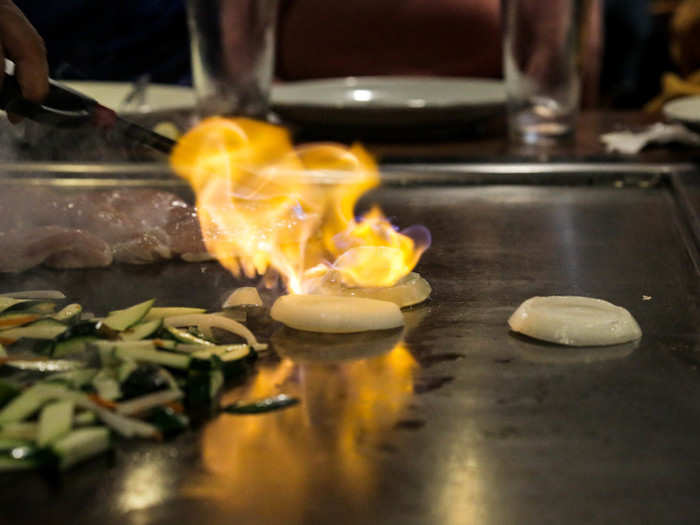
I'd expected the flames to come out of the top of the cone, but instead, the entire onion pile was engulfed in an unforgiving inferno. Later, I looked at videos of others' experiences and realized what I saw was likely not what it was supposed to look like.
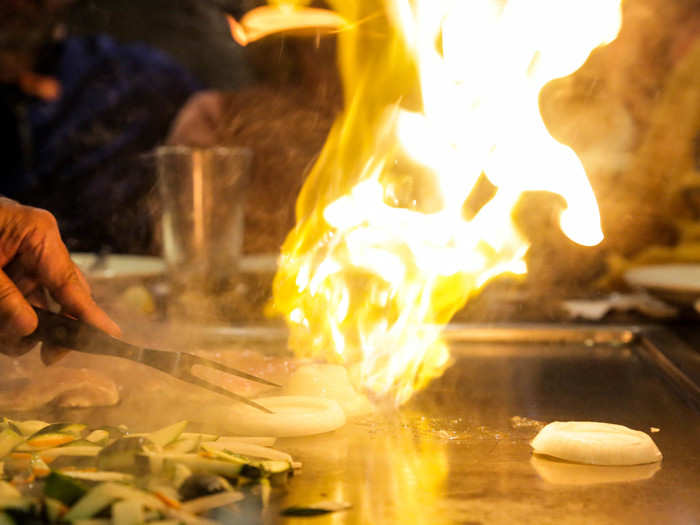
Eventually, the flames did come out of the top of the cone. But before I had time to marvel at Chef Haque's fiery feat, he swept the onions off the grill top into a metal storage container on his cart.
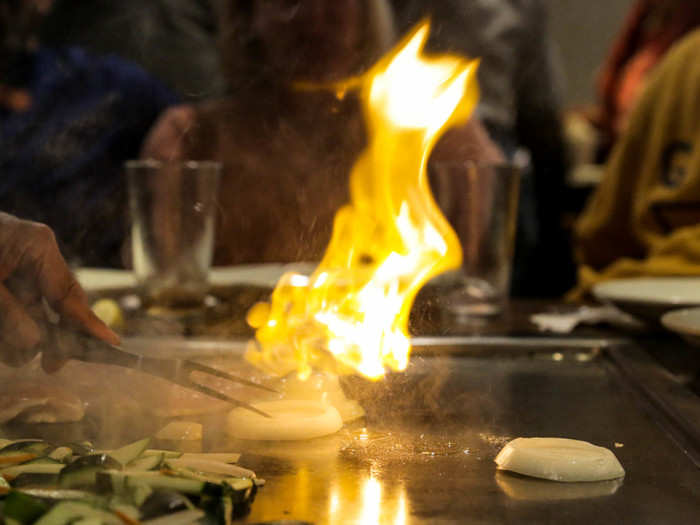
He set two sauces in front of every diner. "Ginger for fish, yum-yum for beef and chicken," he explained.
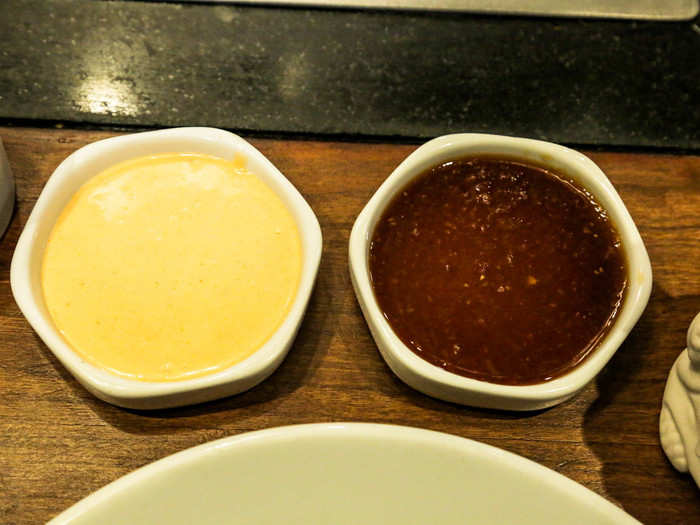
I watched as Chef Haque flicked spoonfuls of butter onto the grilling vegetables. He narrated each ingredient that went onto the grill top. "Soy sauce! Butter! Sesame seeds!"
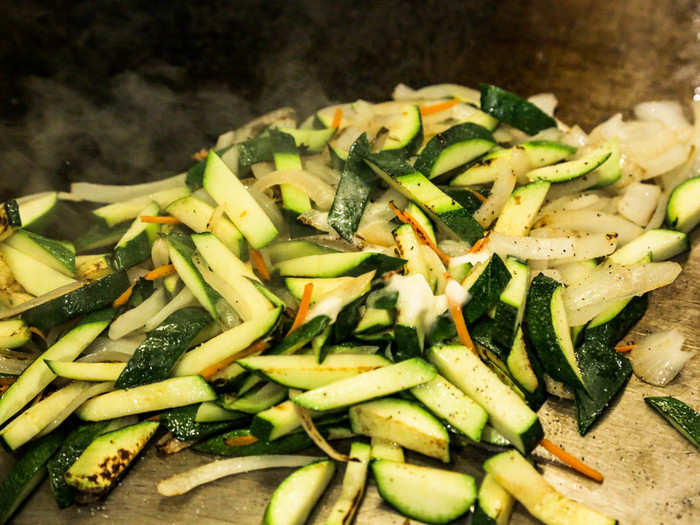
I must have looked skeptical because he assured me: "Everything ooshi." I think he meant to say "oishii," which is Japanese for delicious.
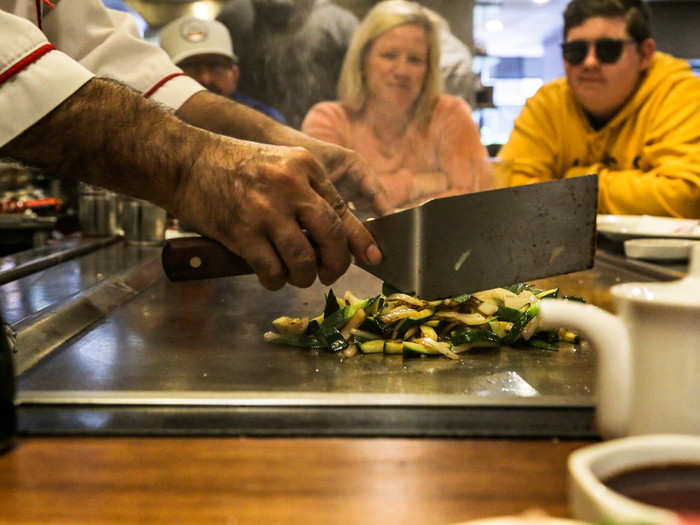
But despite Chef Haque's delightful performance, the vegetables were not oishii.

They were undersalted and underseasoned. I'd seen Chef Haque add soy sauce, but I couldn't taste it. The onions, which had a lovely bit of char to their edges and absorbed a bit more soy sauce, were much tastier than the zucchini.
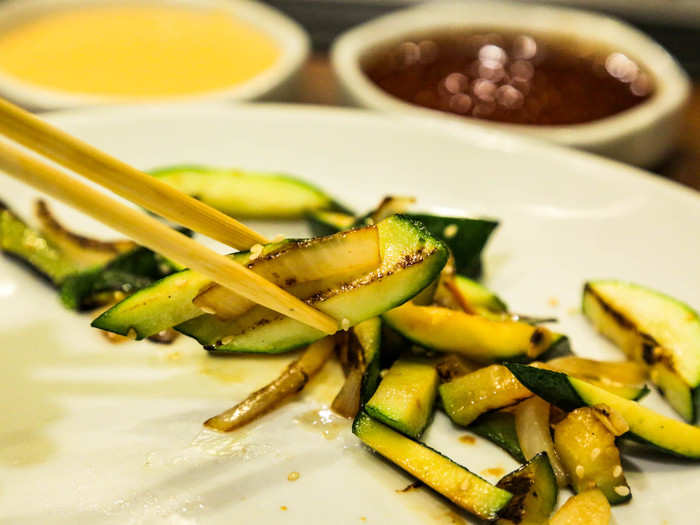
Next, it was time for the famous chicken fried rice. I'd read so much online about how delicious this fried rice was, so I was cautiously optimistic.
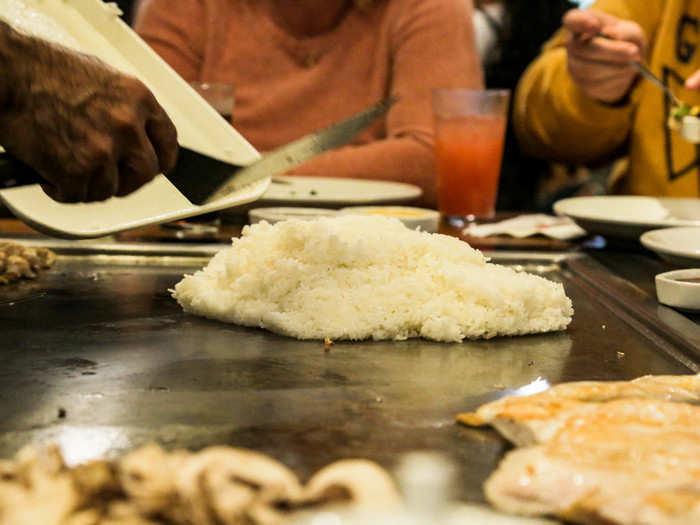
I grew up eating fried rice. It was one of the first dishes I learned to cook, and now I make it all the time.
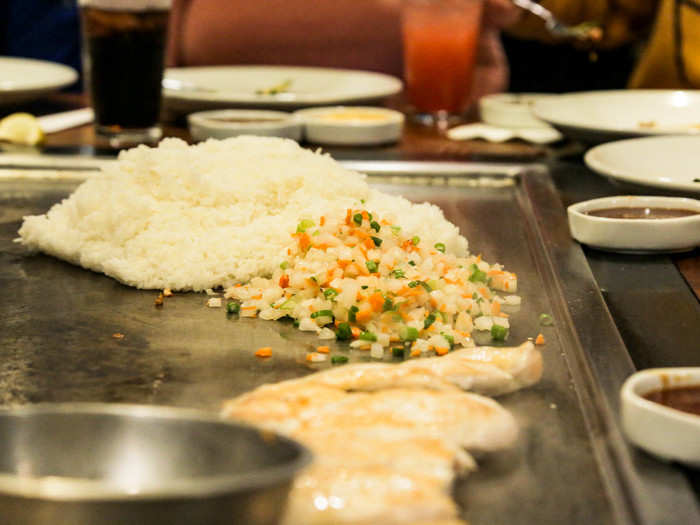
Chef Haque spun an egg onto the grill top, then his spatula, before flipping it into the air and catching it again.
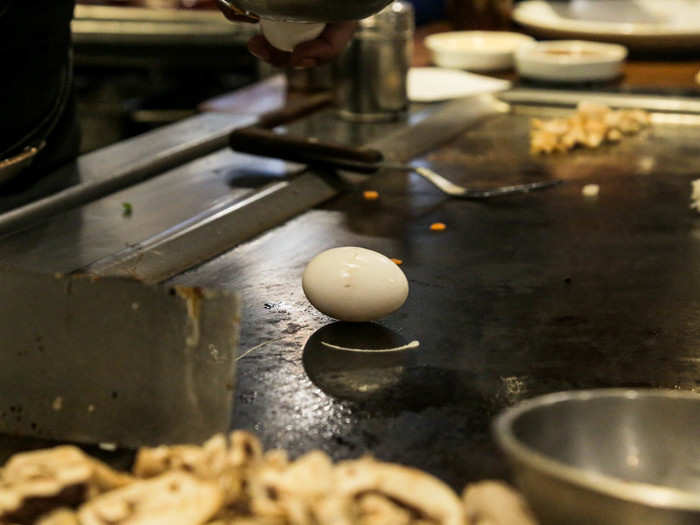
I'd expected him to break the egg while twirling it about, but he simply caught it and cracked it Audrey Hepburn style into a bowl. He did this for four eggs.
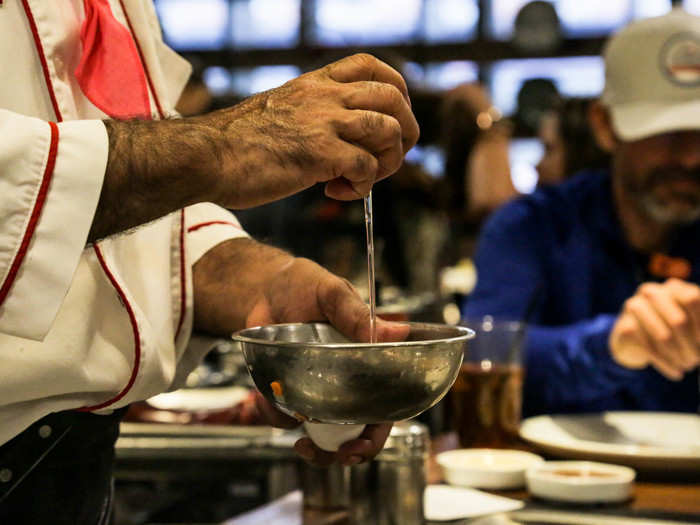
With all the ingredients on the table, Chef Haque began assembling the fried rice.
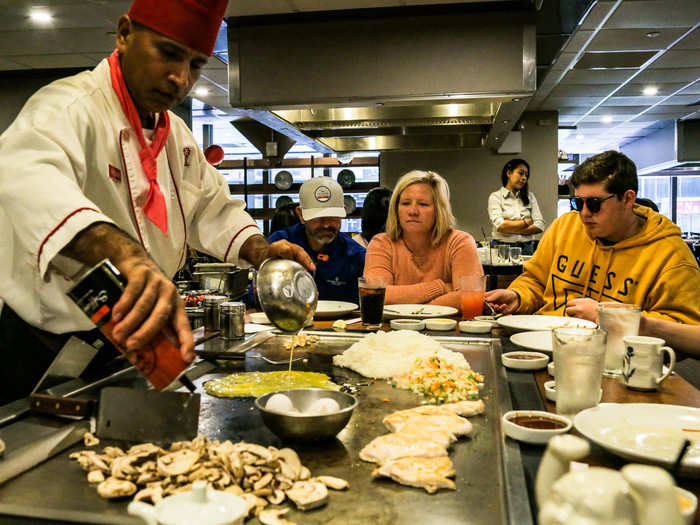
He piled the rice and pre-cut veggies on top of the still-cooking egg. At this point, I was concerned by the rice-to-not-rice ratio, which was slightly higher than I would have liked.
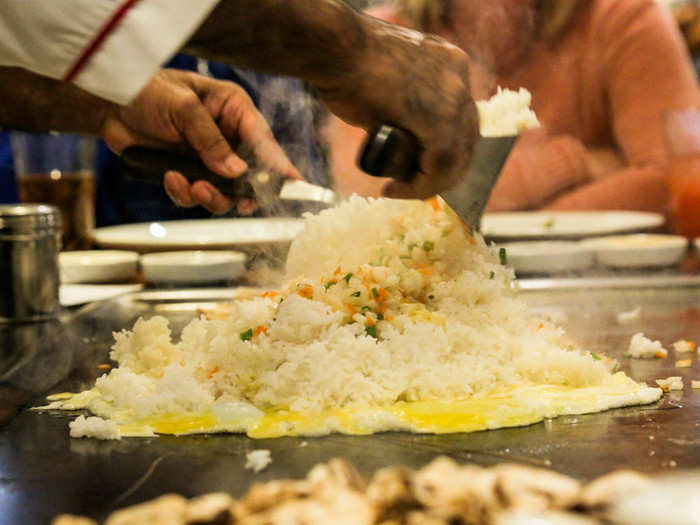
But then he dumped four or five heaping spoonfuls of butter into the rice, and suddenly I understood why people might like it.
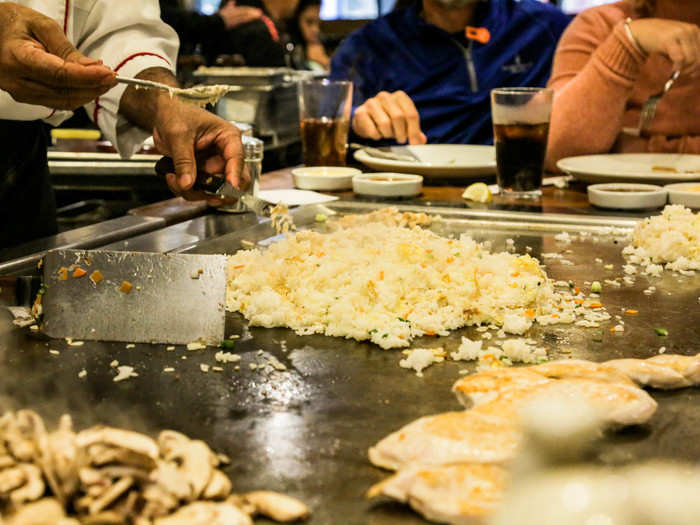
In the blink of an eye, Chef Haque had assembled the rice into shapes: I <3 U. I thought that was a bit forward, as we'd only met a few minutes ago.
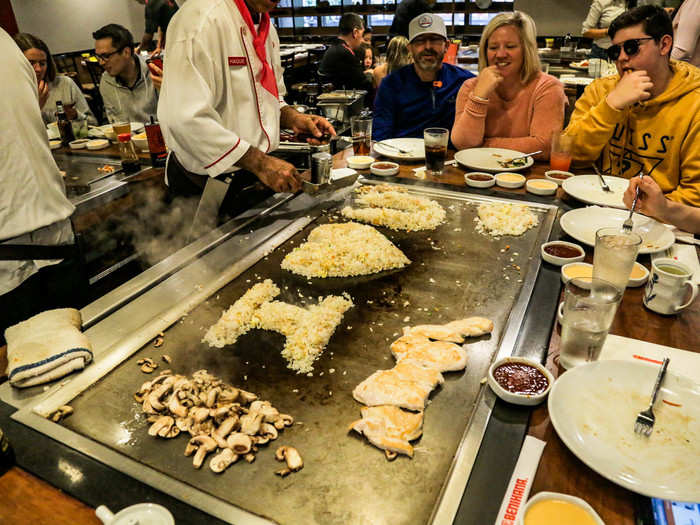
Then, he put his spatula under the heart and made it "beat". He looked up at us as if expecting a response. The Texan woman across the table clapped in delight.
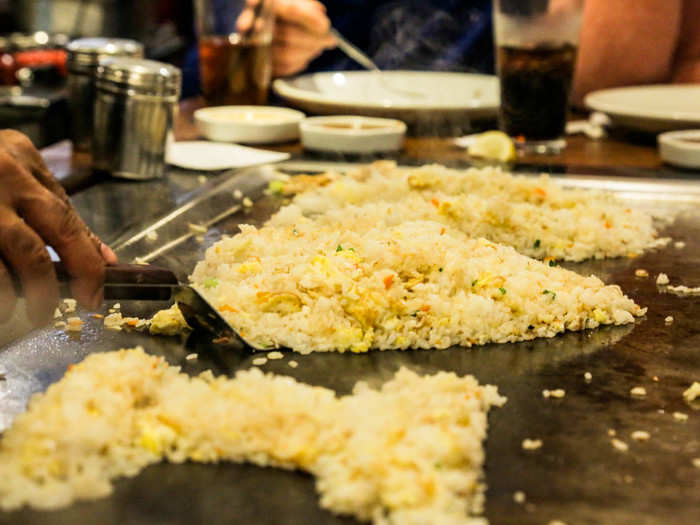
Finally, it was time for Chef Haque to stop playing with our rice and for us to start eating it.
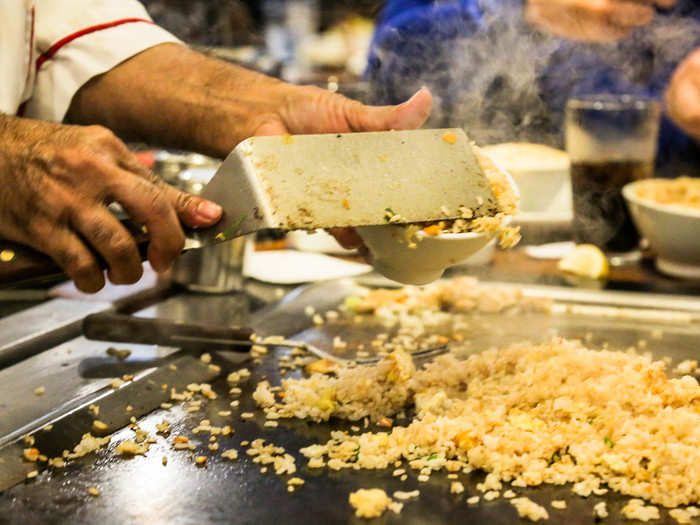
But wait! There was more. Chef Haque tossed each full bowl up in the air before placing it in front of its diner.
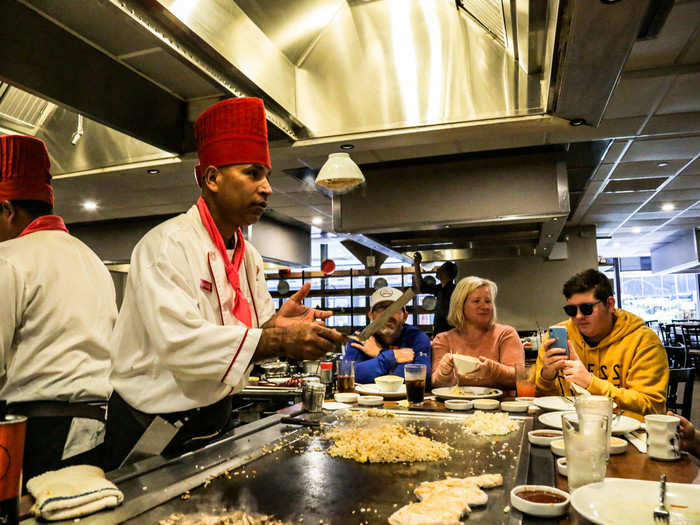
It looked like fried rice, alright. But it hadn't gained significantly more color since it had been first dumped on the grill top.
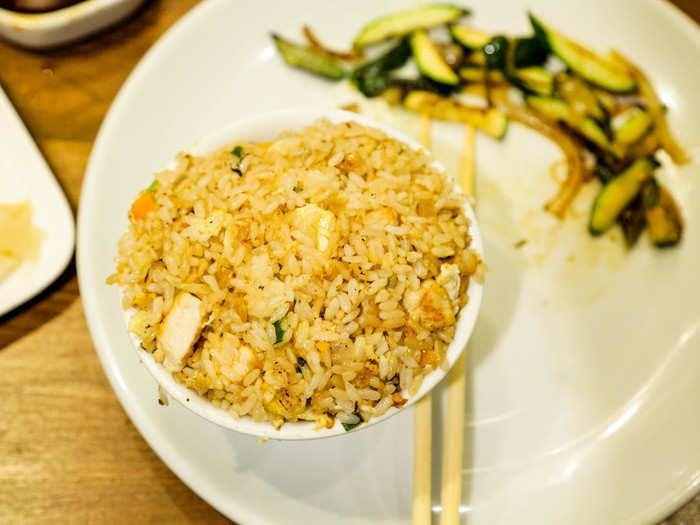
The primary flavor of this fried rice was rice. The second most prominent flavor was butter. It, too, was undersalted. My fear regarding the rice-to-not-rice ratio had come true.
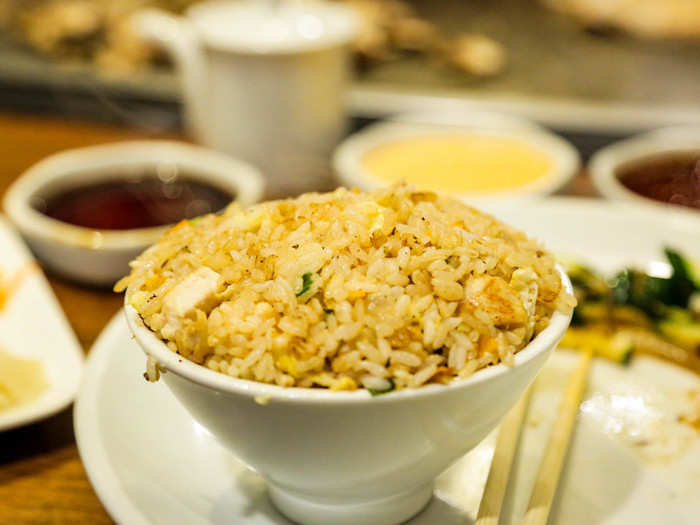
For all I'd heard about this rice being one of the best dishes on the menu, I found it painfully bland.
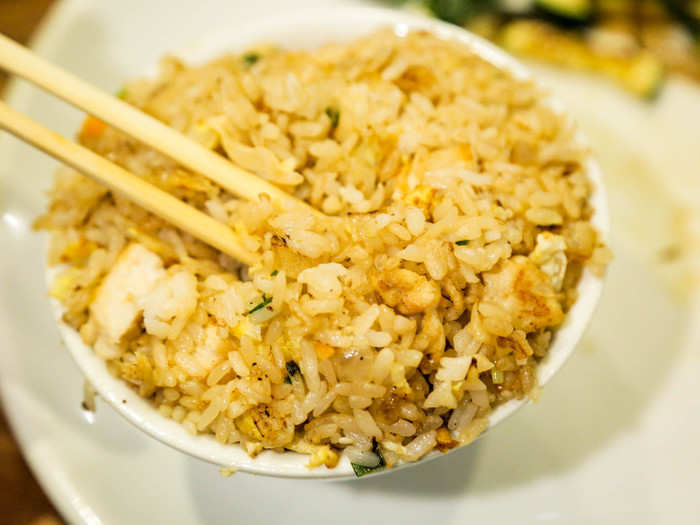
Next, it was time for our seafood appetizers.
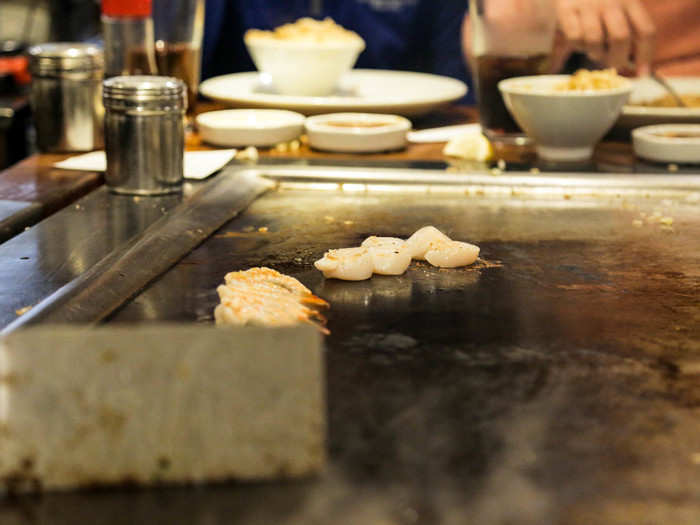
Chef Haque skillfully removed the tails from the shrimp.
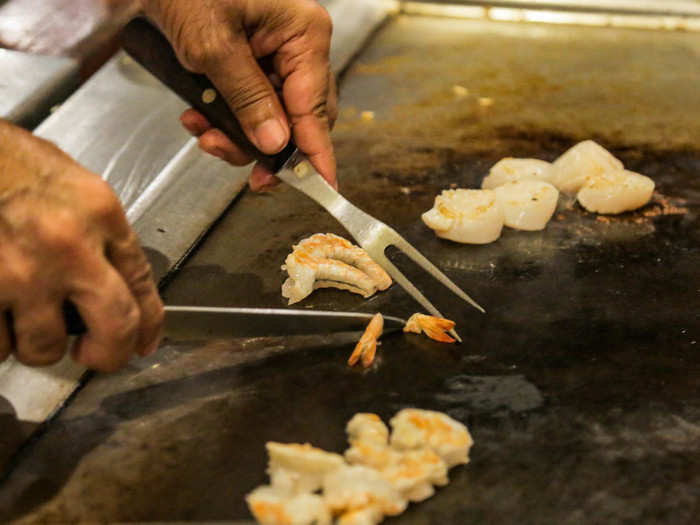
Then, he flipped them one by one into his hat.
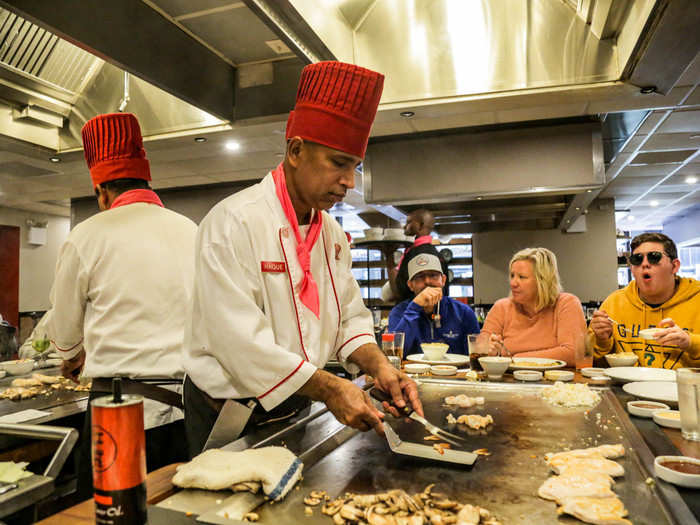
He caught each one and even flipped the last tail into the pocket of his chef's jacket.
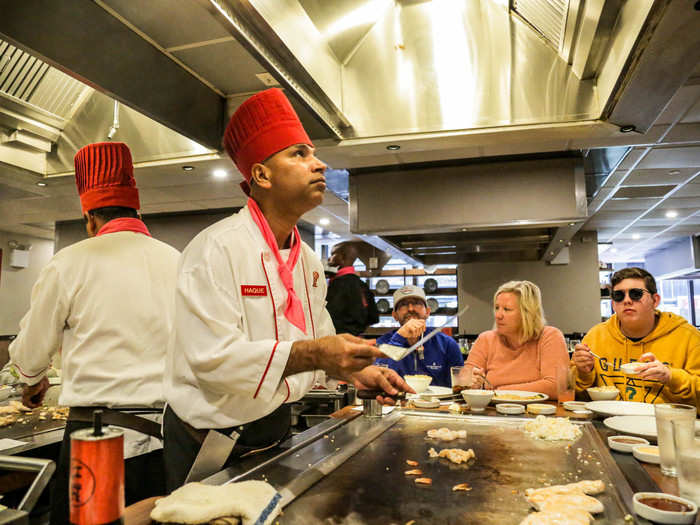
As the seafood was still cooking, Chef Haque slid a few cuts of beef onto the grill top.
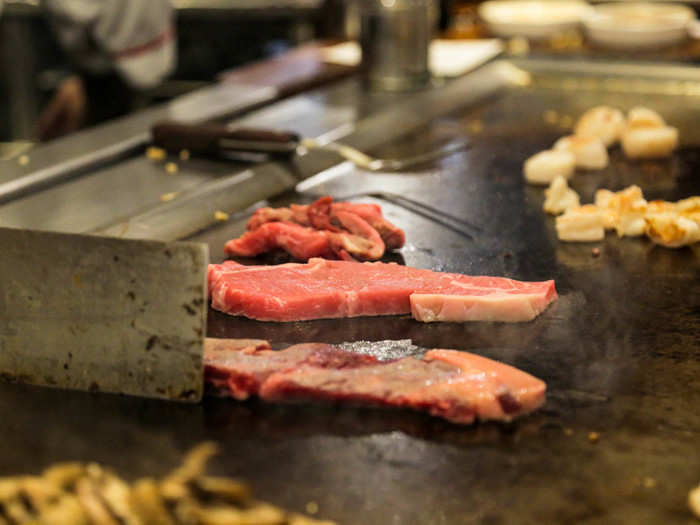
He asked each of us how we'd like our steak cooked. I asked for medium-rare.
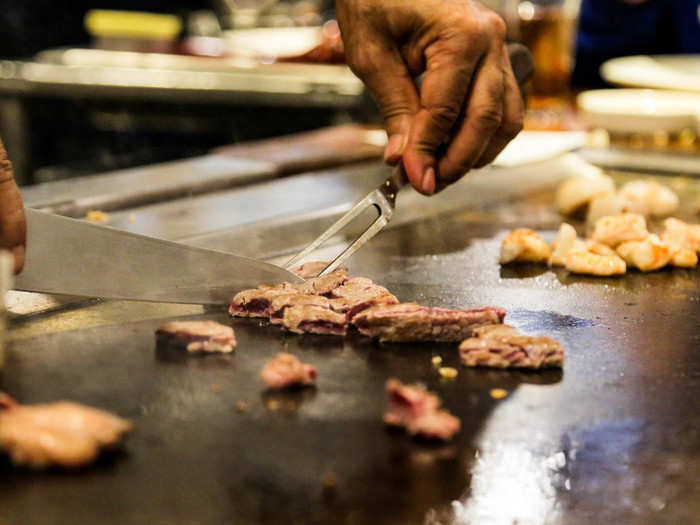
What I got was more medium-well, but oh well.
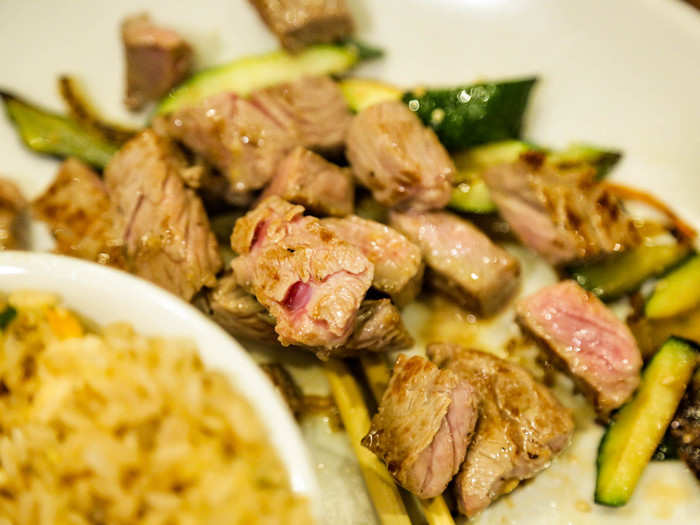
It was cooked tenderly, even if it lacked salt and flavor of any kind. Who needs flavorful beef when you have yum-yum sauce?
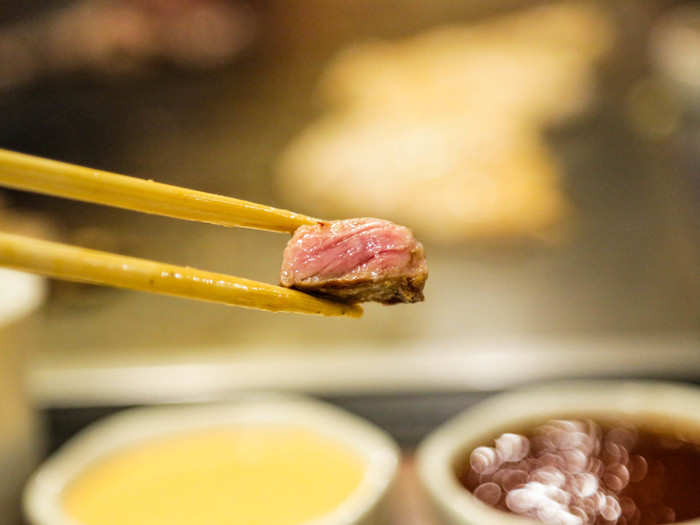
The yum-yum sauce (that's what it's called, I'm not making fun of it) was eerily reminiscent of Outback's Bloomin' sauce: salty, fatty, and horseradishy. There wasn't really anything Japanese or even Asian about it. But it definitely had mass appeal.
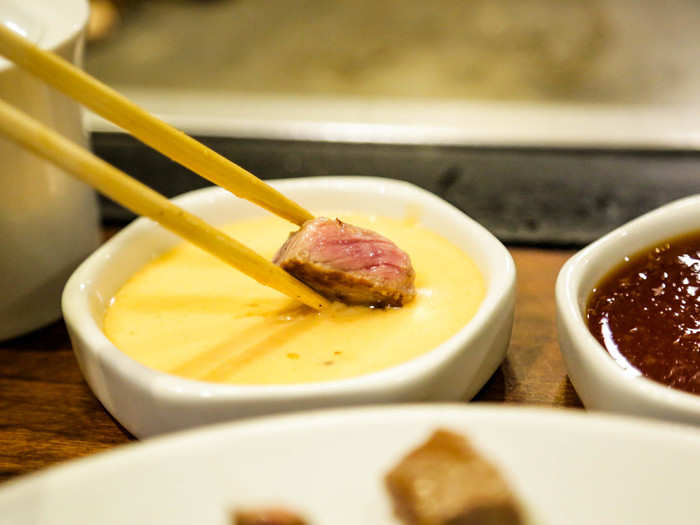
When the shrimp arrived on my plate, they looked quite meager.
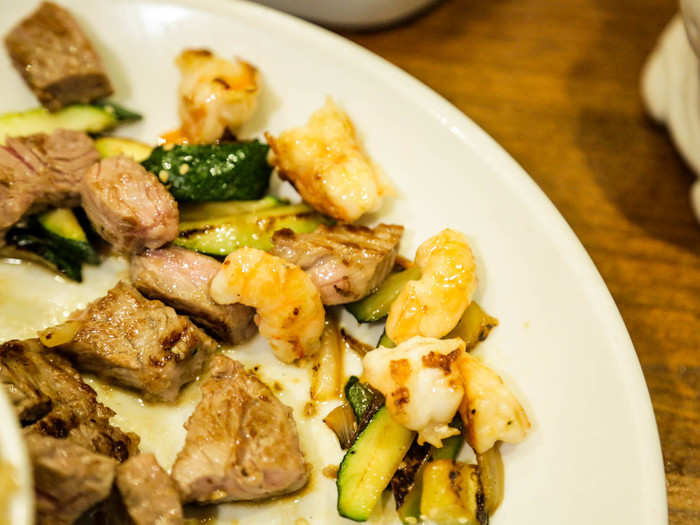
Although they were overcooked, they had a pleasant sweet and sour glaze that had a more distinct flavor than I'd tasted all evening.
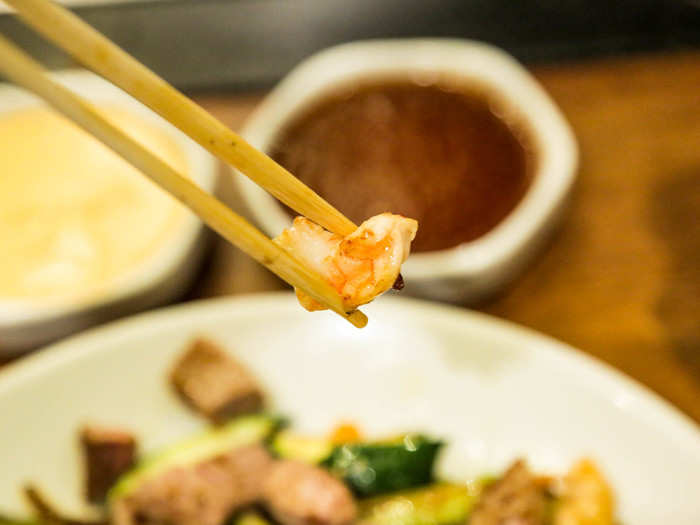
Their flavor was improved manifold with ginger sauce.
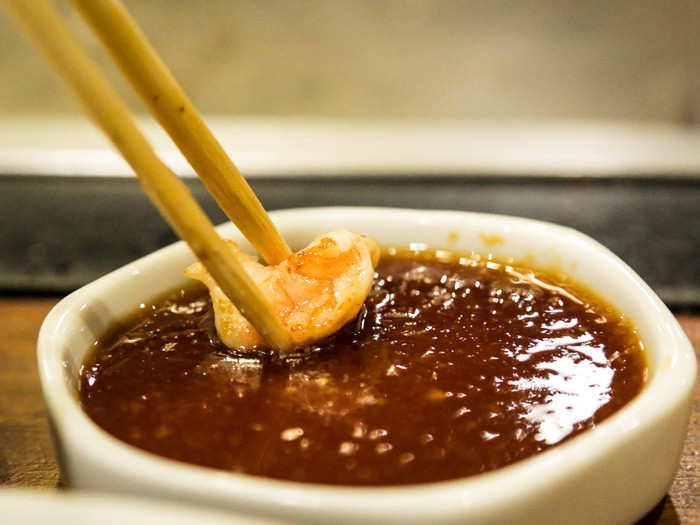
After the shrimp, Chef Haque assembled the chicken.
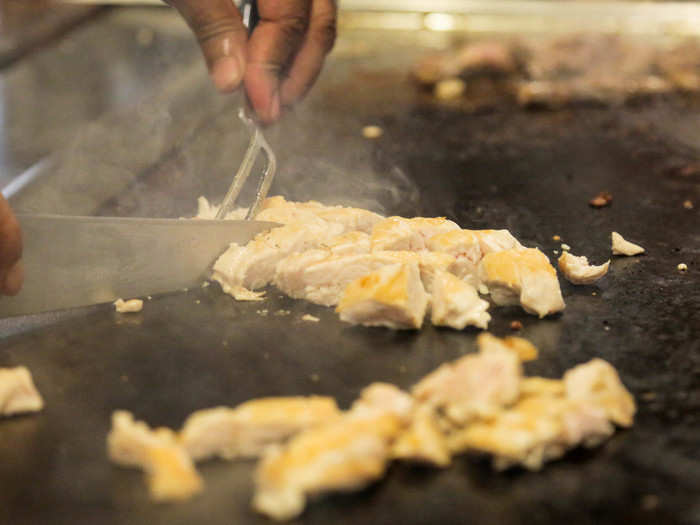
Chef Haque dished out the chicken and the mushrooms, which had also been hanging out on the grill top for a while.
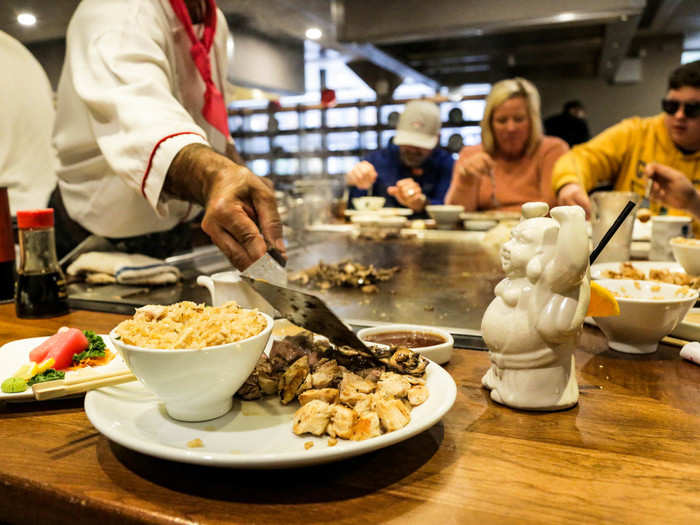
Finally, my meal was complete.
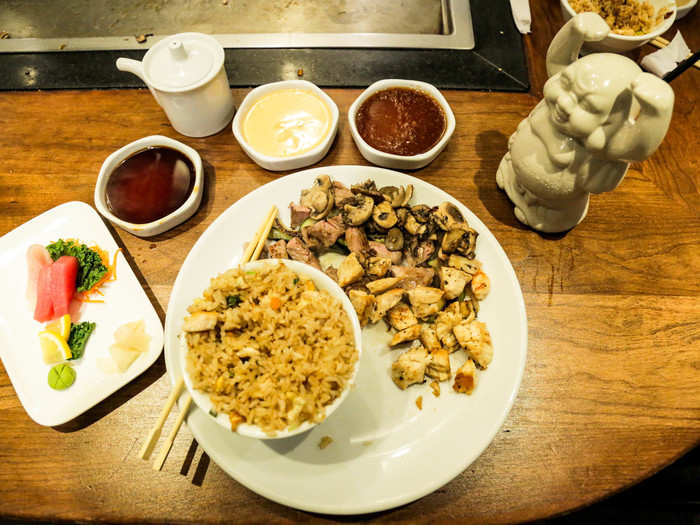
The chicken was overcooked and oversalted.
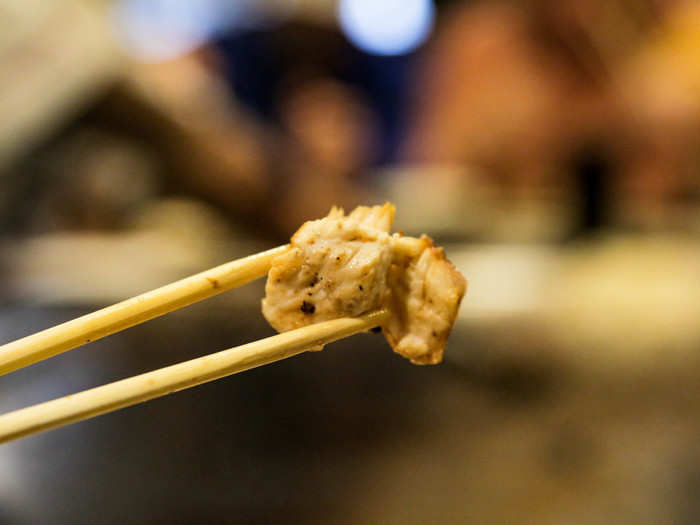
It was also better with yum-yum sauce. Plus, now I had something salty with which to eat my fried rice.
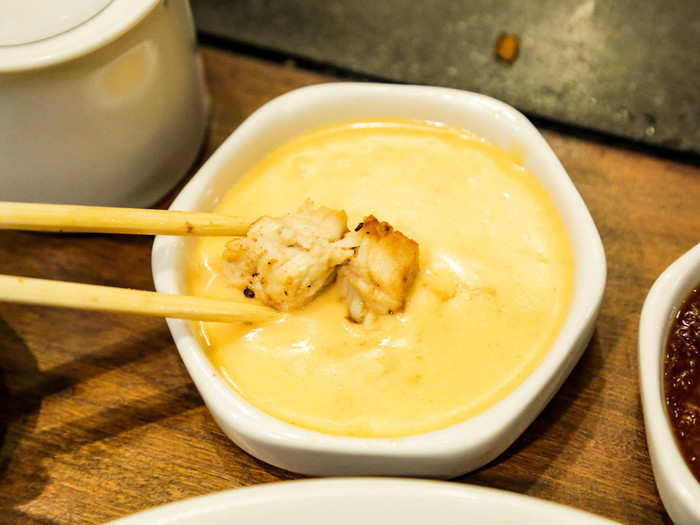
The mushrooms were wholly unremarkable, except that some of them were cooked to the point of being crispy. Eek.
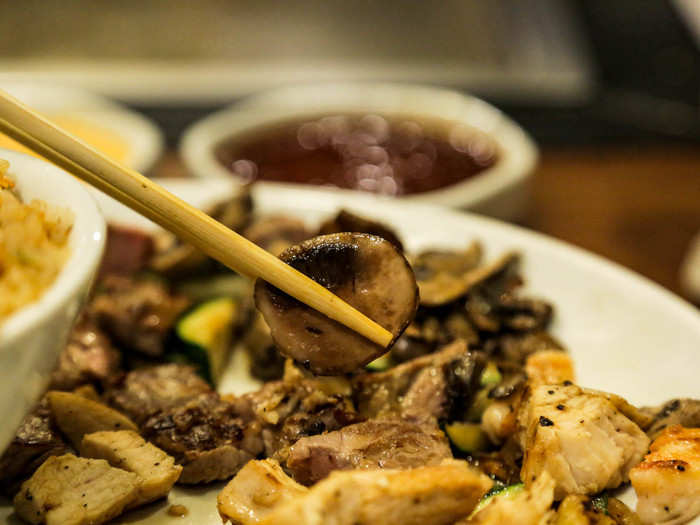
Chef Haque cleaned the stovetop himself, which I thought was great housekeeping but unrelated to his duties as a chef.
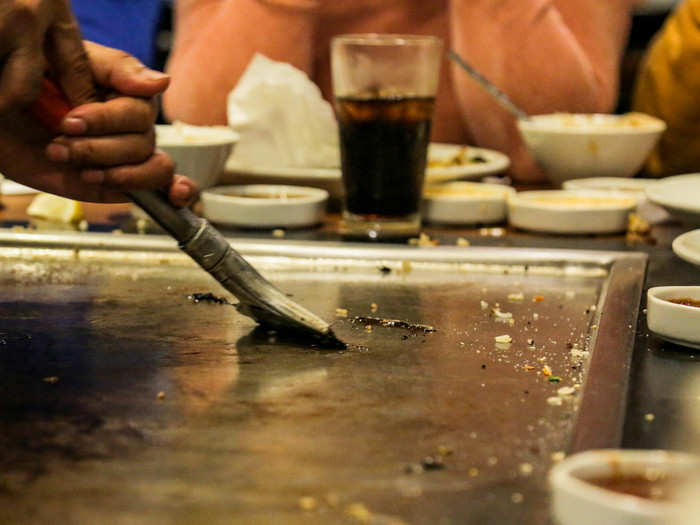
He ended the meal by banging and flipping two sticks on the teppanyaki grill. I'm not sure if this is Benihana-specific or universal to all teppanyaki dining experiences, as I've never had teppanyaki before.
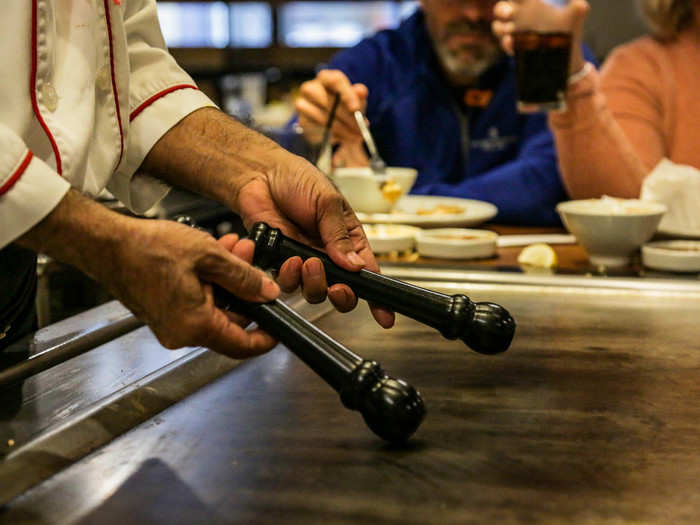
He concluded the ritual with a bow and an "arigato." Then we said goodbye to Chef Haque.
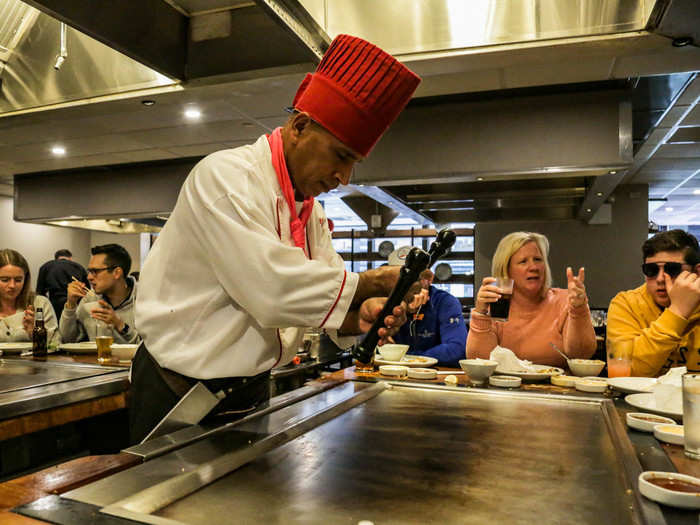
As our server wrapped things up, I chatted with the students. They told me that they had fond memories of dining at Benihana with their families as children and had wanted to recreate the experience today, but they'd found the food just as bland as I had.
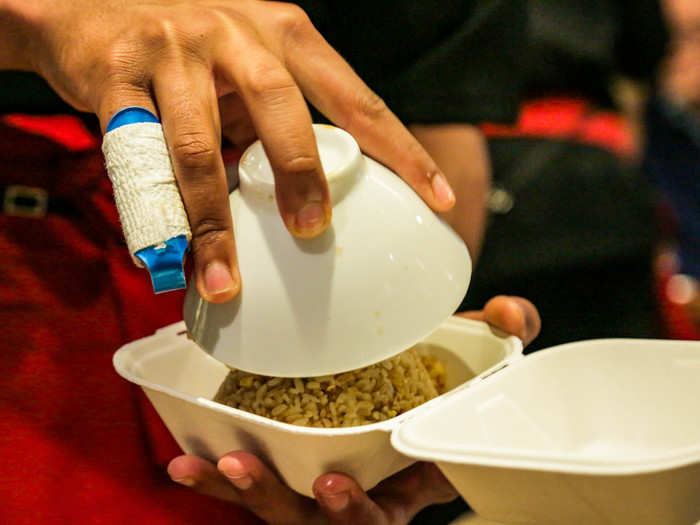
But wait! There was one more course: ice cream and hot green tea. The choices of ice cream were chocolate, strawberry, and green tea. I chose the green tea.
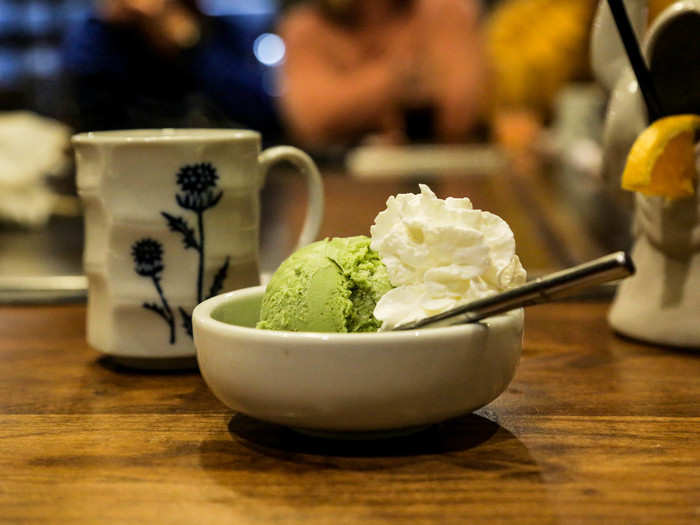
The green tea ice cream was probably store-bought but definitely the tastiest part of this meal. It was also the only part of the meal I could see my Chinese-American parents enjoying.
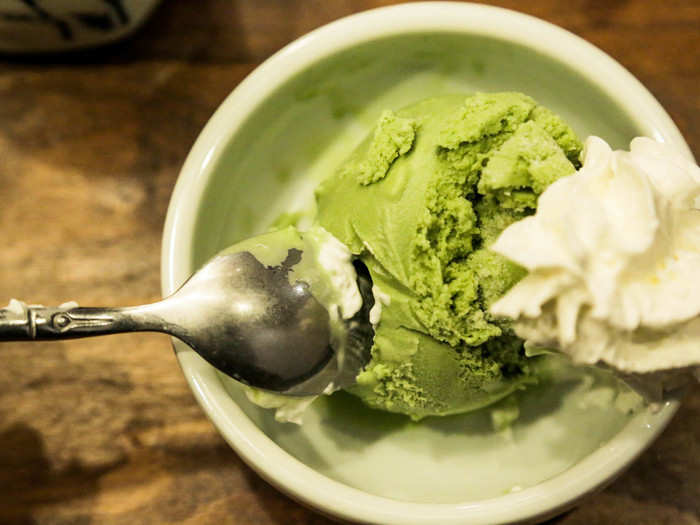
The green tea wasn't Lipton, but it certainly was no tea of quality. It was pleasant and inoffensive.
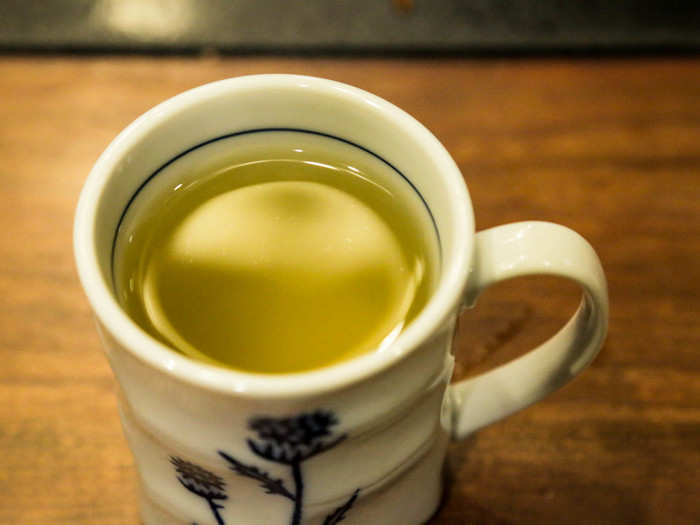
So I went back to the ice cream and polished it off. After all, why let a good thing go to waste?
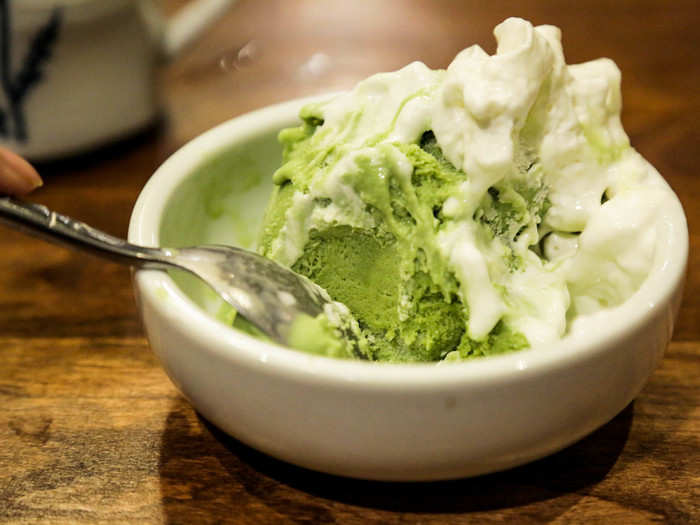
After the others had left, the server asked me if I wanted a free Benihana Polaroid. I posed glibly for the picture with my collectible mug. A few minutes later, he came back and apologized profusely. The photo printer was broken.
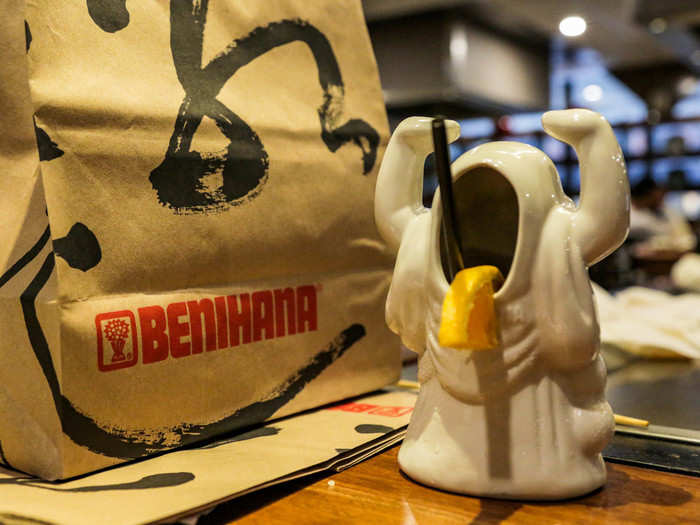
While I can't say I enjoyed the food at Benihana, I felt like I learned a lot from my visit and I can see how its food would have been novel and "exotic" at the time it was introduced.
Benihana is like my parents' generation of Asian immigrants to the US. It had to assimilate in order to have a chance of success in this country, and as a result, lost a lot of its home country's culture.
But most importantly, it paved the way for the next generation to make an even bigger impact. Hibachi and teppanyaki grills are all over America's small towns and big cities.
Asian restaurants throughout the country serve food that's much more similar to hometown cooking, such as stinky tofu, drunken crab, tonkotsu ramen, kimchi tofu soup, and even sisig — all foods that would have been unthinkable to put on a restaurant menu when Benihana first opened 55 years ago.
Still, it may be time for this old-timer to put down the metal spatulas and stroll into its sunset.
Popular Right Now
Popular Keywords
Advertisement